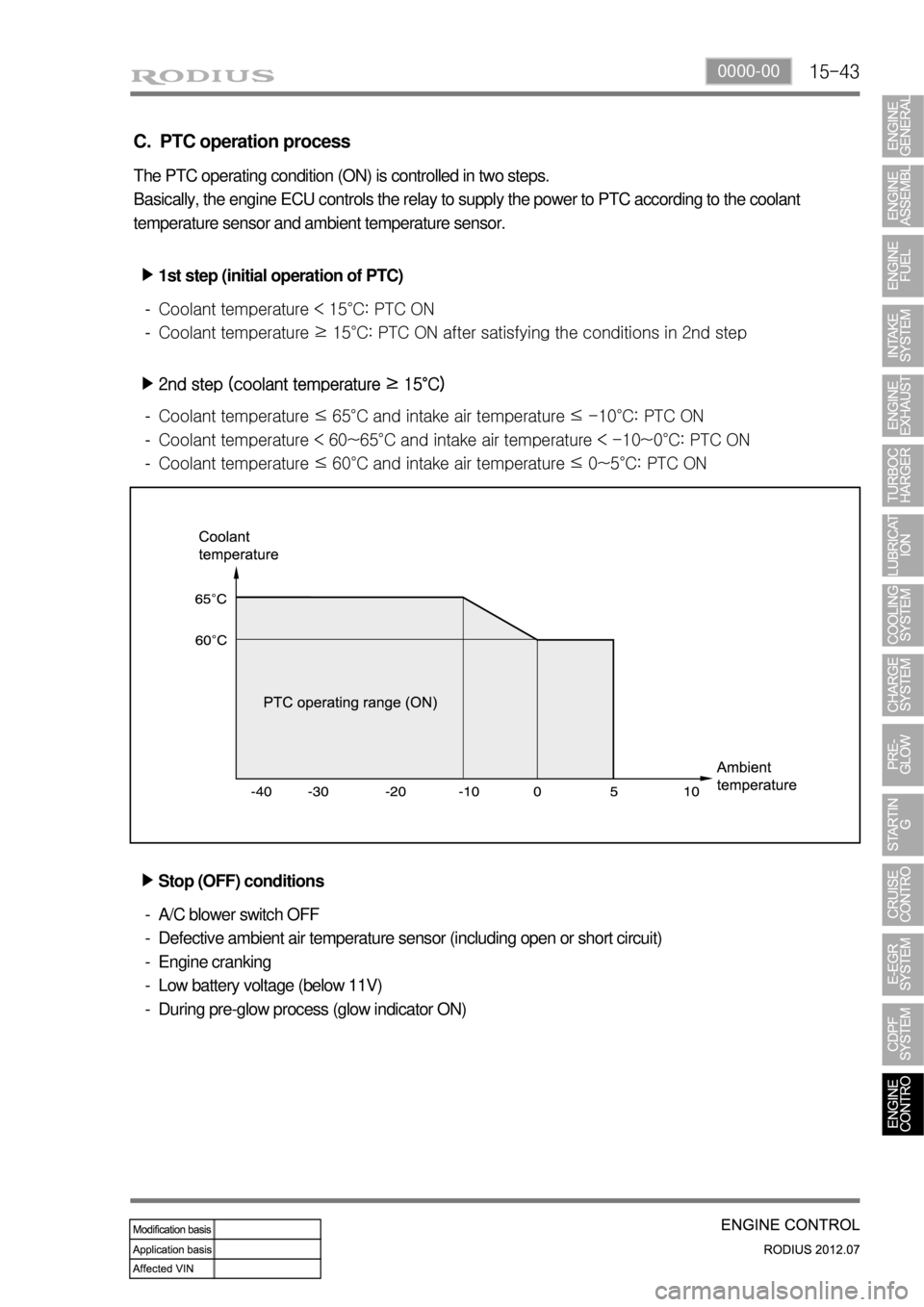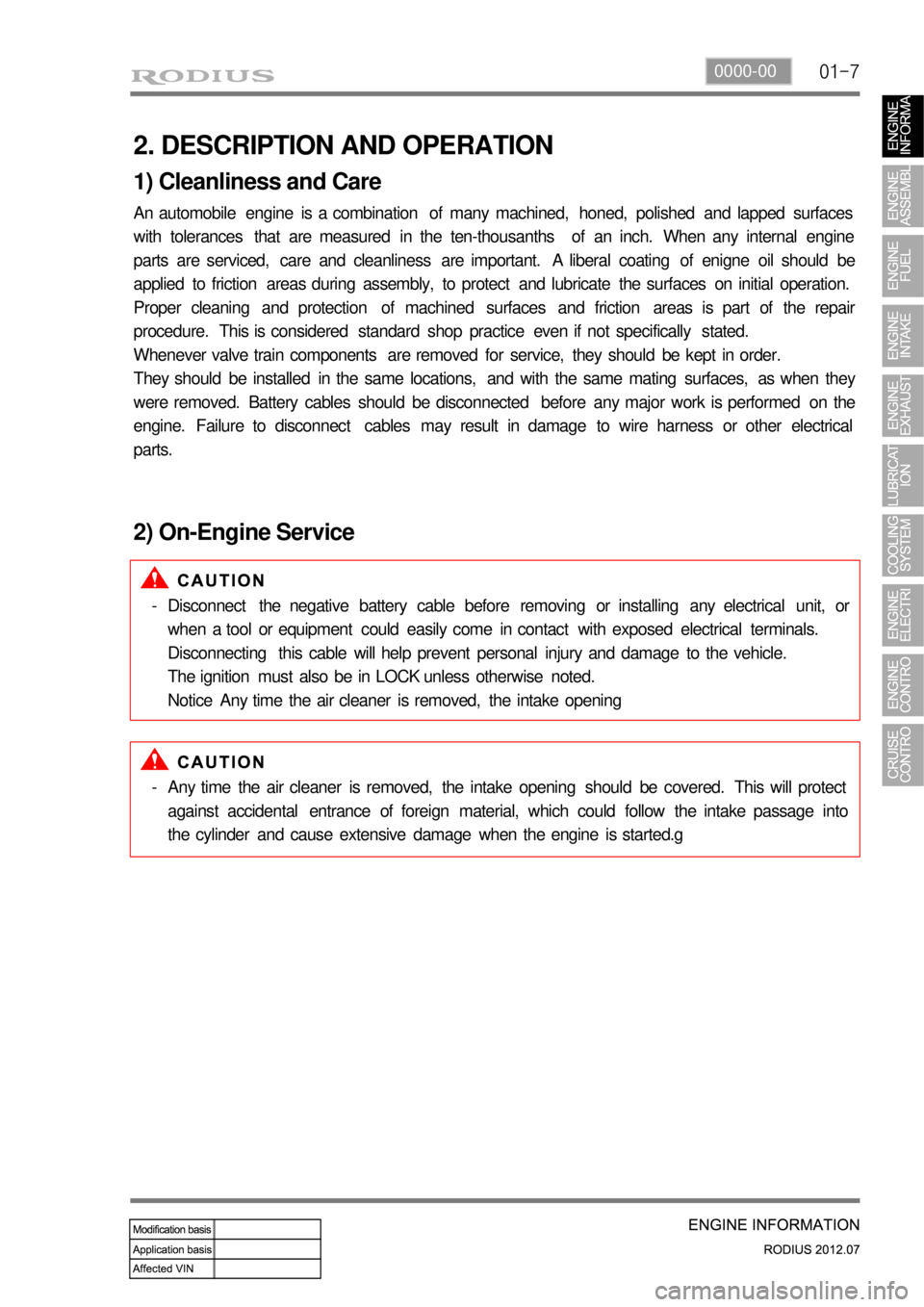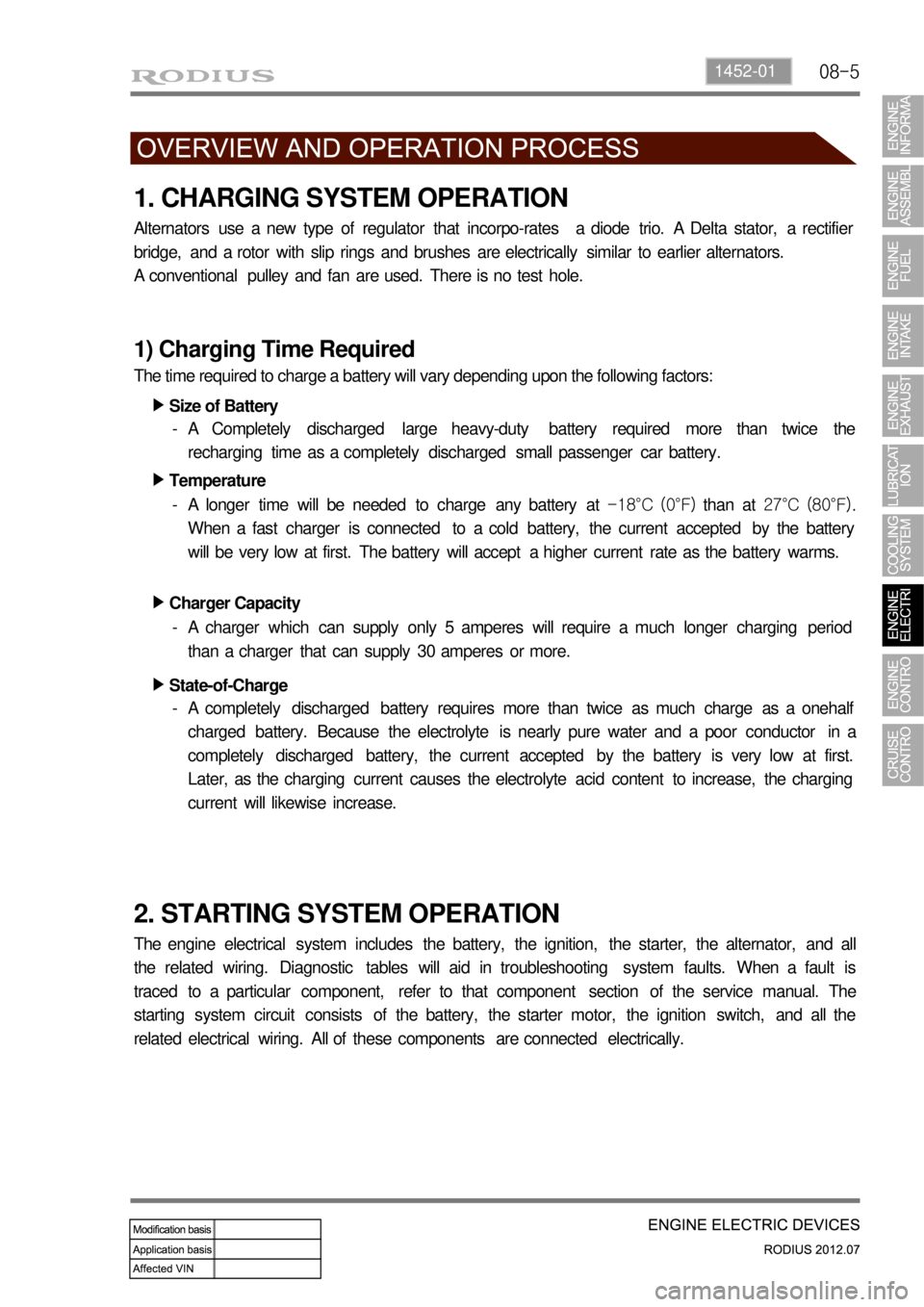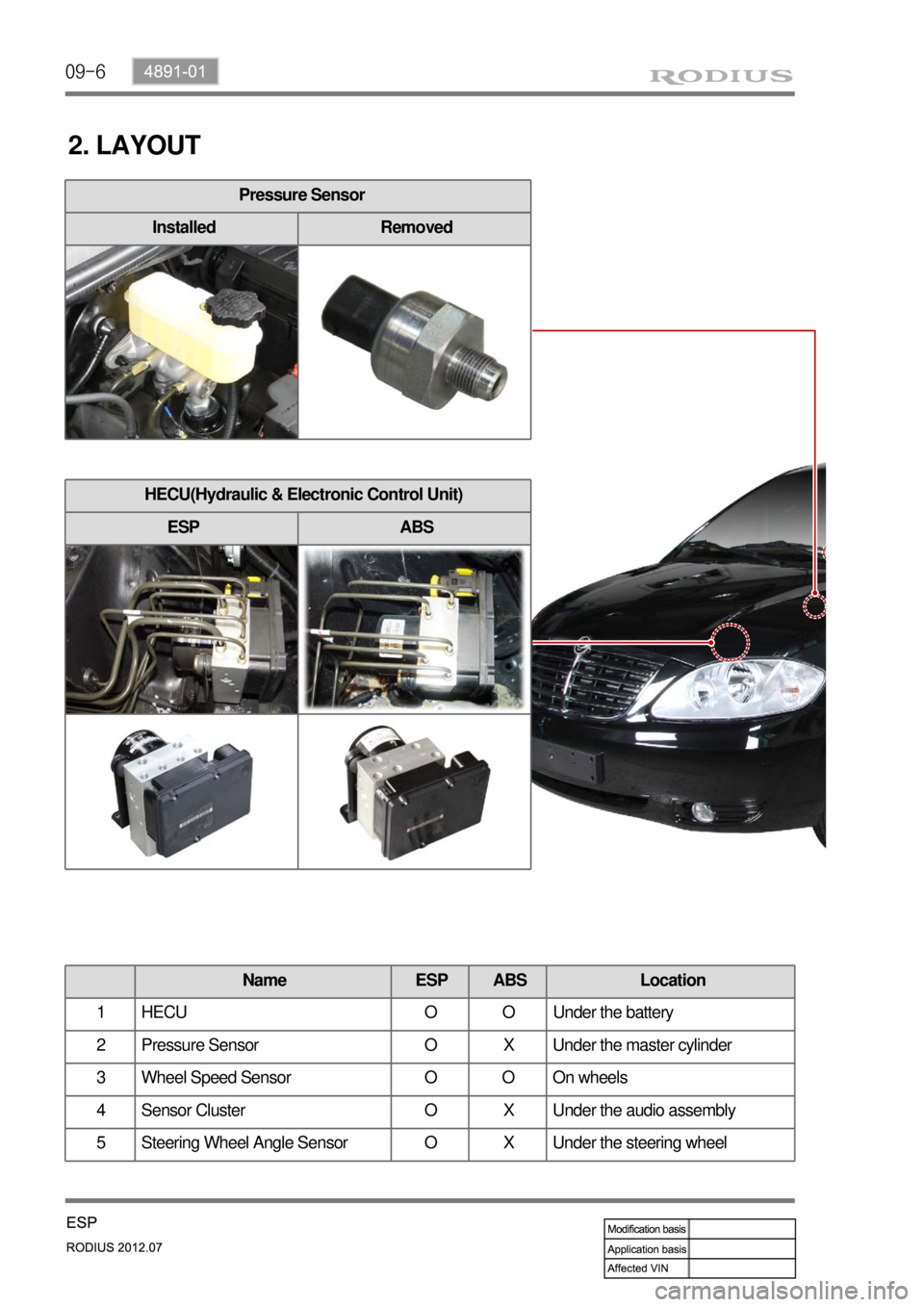battery SSANGYONG RODIUS 2012 Owner's Manual
[x] Cancel search | Manufacturer: SSANGYONG, Model Year: 2012, Model line: RODIUS, Model: SSANGYONG RODIUS 2012Pages: 715, PDF Size: 79.36 MB
Page 368 of 715

15-430000-00
C. PTC operation process
The PTC operating condition (ON) is controlled in two steps.
Basically, the engine ECU controls the relay to supply the power to PTC according to the coolant
temperature sensor and ambient temperature sensor.
1st step (initial operation of PTC) ▶
Coolant temperature < 15°C: PTC ON
<006a00960096009300880095009b0047009b008c00940097008c00990088009b009c0099008c004702fb00470058005c00b6006a006100470077007b006a00470076007500470088008d009b008c00990047009a0088009b0090009a008d00a00090009500
8e0047009b008f008c0047008a00960095008b0090009b0090>ons in 2nd step -
-
2nd step (coolant temperature ≥ 15°C) ▶
<006a00960096009300880095009b0047009b008c00940097008c00990088009b009c0099008c004702fa0047005d005c00b6006a004700880095008b004700900095009b00880092008c00470088009000990047009b008c00940097008c00990088009b00
9c0099008c004702fa004700540058005700b6006a00610047>PTC ON
<006a00960096009300880095009b0047009b008c00940097008c00990088009b009c0099008c004700630047005d005700a5005d005c00b6006a004700880095008b004700900095009b00880092008c00470088009000990047009b008c00940097008c00
990088009b009c0099008c00470063004700540058005700a5>0°C: PTC ON
<006a00960096009300880095009b0047009b008c00940097008c00990088009b009c0099008c004702fa0047005d005700b6006a004700880095008b004700900095009b00880092008c00470088009000990047009b008c00940097008c00990088009b00
9c0099008c004702fa0047005700a5005c00b6006a00610047>PTC ON -
-
-
Stop (OFF) conditions ▶
A/C blower switch OFF
Defective ambient air temperature sensor (including open or short circuit)
Engine cranking
Low battery voltage (below 11V)
During pre-glow process (glow indicator ON) -
-
-
-
-
Page 379 of 715

01-70000-00
2. DESCRIPTION AND OPERATION
1) Cleanliness and Care
An automobile engine is a combination of many machined, honed, polished and lapped surfaces
with tolerances that are measured in the ten-thousanths of an inch. When any internal engine
parts are serviced, care and cleanliness are important. A liberal coating of enigne oil should be
applied to friction areas during assembly, to protect and lubricate the surfaces on initial operation.
Proper cleaning and protection of machined surfaces and friction areas is part of the repair
procedure. This is considered standard shop practice even if not specifically stated.
Whenever valve train components are removed for service, they should be kept in order.
They should be installed in the same locations, and with the same mating surfaces, as when they
were removed. Battery cables should be disconnected before any major work is performed on the
engine. Failure to disconnect cables may result in damage to wire harness or other electrical
parts.
2) On-Engine Service
Disconnect the negative battery cable before removing or installing any electrical unit, or
when a tool or equipment could easily come in contact with exposed electrical terminals.
Disconnecting this cable will help prevent personal injury and damage to the vehicle.
The ignition must also be in LOCK unless otherwise noted.
Notice Any time the air cleaner is removed, the intake opening -
Any time the air cleaner is removed, the intake opening should be covered. This will protect
against accidental entrance of foreign material, which could follow the intake passage into
the cylinder and cause extensive damage when the engine is started.g -
Page 402 of 715

08-51452-01
1. CHARGING SYSTEM OPERATION
Alternators use a new type of regulator that incorpo-rates a diode trio. A Delta stator, a rectifier
bridge, and a rotor with slip rings and brushes are electrically similar to earlier alternators.
A conventional pulley and fan are used. There is no test hole.
1) Charging Time Required
The time required to charge a battery will vary depending upon the following factors:
Size of Battery ▶
A Completely discharged large heavy-duty battery required more than twice the
recharging time as a completely discharged small passenger car battery. -
Temperature ▶
A longer time will be needed to charge any battery at -18°C (0°F) than at 27°C (80°F).
When a fast charger is connected to a cold battery, the current accepted by the battery
will be very low at first. The battery will accept a higher current rate as the battery warms. -
Charger Capacity ▶
A charger which can supply only 5 amperes will require a much longer charging period
than a charger that can supply 30 amperes or more. -
State-of-Charge ▶
A completely discharged battery requires more than twice as much charge as a onehalf
charged battery. Because the electrolyte is nearly pure water and a poor conductor in a
completely discharged battery, the current accepted by the battery is very low at first.
Later, as the charging current causes the electrolyte acid content to increase, the charging
current will likewise increase. -
2. STARTING SYSTEM OPERATION
The engine electrical system includes the battery, the ignition, the starter, the alternator, and all
the related wiring. Diagnostic tables will aid in troubleshooting system faults. When a fault is
traced to a particular component, refer to that component section of the service manual. The
starting system circuit consists of the battery, the starter motor, the ignition switch, and all the
related electrical wiring. All of these components are connected electrically.
Page 417 of 715

01-38410-02
1. CAUTIONS WHEN WORKING ON ELECTRICAL UNITS
80℃
10A 15A
Disconnect the negative cable from the
battery in advance when working on
electrical units. -
Make sure to turn "OFF" the ignition switch
and other lamp switches before
disconnecting or connecting the negative
battery cable. (Otherwise, semiconductor
parts can be damaged.)
Do not drop or appy excessive impact to
sensors and relays. -
If a fuse is blown, replace it with a fuse
which has the correct amperage rating. If
you use a fuse with higher capacity than
the specification, the component can be
damaged or catch fire. -
Page 436 of 715

02-58710-01
The remote engine control function has been deleted in this model.
1. COMPONENTS
STICS / ICM module
Air bag ECU
Sends the vehicle collision
signals to STICS.
Theft deterrent horn
Installed under the battery.
This horn works only for the
theft deterrent function,
panic function, and remote
starting.
SCAN-tool
SIW is used for REKES key
coding and trouble
diagnosis.
REKES
Added the escort and
panic function
RK STICS
ICM module
This module contains
various relays, chime and
buzzer controlled by STICS
Page 458 of 715

02-278710-01
9) Battery Saver (Tail Lamp Auto Cut)
The tail lamp is turn on or off according to the operations of the multifunction tail lamp switch.
<007b008f008c0047009b0088009000930047009300880094009700470099008c0093008800a000470090009a0047009b009c00990095008c008b00470096008d008d0047004f0088009c009b00960047008a009c009b00500047009e008f008c0095004700
960097008c009500900095008e004700880095008b0047008a>losing the driver’s door after
removing the ignition key without turning off the tail lamp.
Tail lamp relay is turned on when inserting the ignition key into ignition switch again after step 2
operation.
<007b008f008c0047009b0088009000930047009300880094009700470099008c0093008800a000470090009a0047009b009c00990095008c008b00470096008d008d0047004f0088009c009b00960047008a009c009b00500047009e008f008c0095004700
960097008c009500900095008e004700880095008b0047008a>losing the driver’s door while the
ignition key is removed and the tail lamp is turned on. 1.
2.
3.
4.
Page 461 of 715

02-30
11) Door LOCK/UNLOCK Control
<007b008f008c0047008b009600960099004700930096008a00920047009a00a0009a009b008c009400470096009c009b0097009c009b009a004702c800730076006a007202c90047008d00960099004700570055005c0047009a008c008a00960095008b00
9a0047004f007b005800500047009e008f008c009500470097>ositioning the driver’s or
<00970088009a009a008c0095008e008c009902c5009a0047008b009600960099004700930096008a00920047009a009e0090009b008a008f0047009b0096004700930096008a0092004700970096009a0090009b0090009600950047004f009e008f009000
93008c0047009b008f008c0047008b00990090009d008c0099>’s and passenger’s door lock
switch is in “UNLOCK” position).
<007b008f008c0047008b009600960099004700930096008a00920047009a00a0009a009b008c009400470096009c009b0097009c009b009a004702c8007c007500730076006a007202c90047008d00960099004700570055005c0047009a008c008a009600
95008b009a0047004f007b005900500047009e008f008c0095> positioning the driver’s or
passenger’s door lock switch to unlock position.
<02c800730076006a007202c9004700960099004702c8007c007500730076006a007202c90047008900a00047009b008f008c0047008b009600960099004700930096008a00920047009a009e0090009b008a008f00470090009a00470090008e0095009600
99008c008b0047009e008f008c009500470096009c009b0097>utting the “LOCK” or
“UNLOCK” by other functions.
The door lock/unlock system is not working regardless of the door lock switch positions when
connecting the battery.
<0068009300930047008b009600960099004700930096008a00920047009a0090008e009500880093009a004700880099008c004702c8007c007500730076006a007202c90047008d00960099004700570055005c0047009a008c008a00960095008b009a00
47004f007b005b005000470091009c009a009b0047008d0096>r once when receiving the
<02c800730076006a007202c90047009a0090008e0095008800930047009e0090009b008f00900095004700570055005c0047009a008c008a00960095008b009a0047004f007b005a005000470088008d009b008c00990047008a00930096009a0090009500
8e0047009b008f008c0047008b00990090009d008c009902c5>s or
passenger’s door. However,
this operation is regardless of the ignition key positions. 1.
2.
3.
4.
5. ▶Door Lock/Unlock by Door Lock Switch
This function prevents the door from locking by shock when slamming a door while the
ignition key is inserted into the key switch hole. -
Page 479 of 715

03-6
Transponder
3. VERIFICATION OF KEY
1) Verification
The immobilizer system prevents the vehicle theft by allowing only the authorized key to start the
engine. The transponder inside the key communicates with the immobilizer installed in the key
box, and the system permits the engine to start after confirming the encrypted coding from the
engine ECU.
In the following cases, a driver may be unable to start the vehicle with the immobilizer.The immobilizer unit transmits
the encrypted code to the
transponder. (2)
The transponder sends an encrypted signal to the unit as a response.
The transmitted code is changed to an encrypted signal in the unit.
The system compares the signal from transponder and the encrypted signal in immobilizer unit. (3)
(4)
(5)
When two or more immobilizer keys come into contact with (each) other(s).
When the key is close to any device sending or receiving electromagnetic fields or waves.
When the key is close to any electronic or electric devices such as lightening equipment,
security keys or security cards.
When the key is close to a magnetic or metal object or a battery. -
-
-
-
Immobilizer Unit
Page 612 of 715

09-4
2) Sensor Cluster
3) Steering Wheel Angle Sensor
Air gap between sensor and rotorFront 0.335 ~ 0.945mm
Rear 0.309 ~ 0.958mm
Current (at 2.75 km/h)IHIGH : 14mA
ILOW : 7mA
Voltage (when turning the steering wheel one turn per second) 7.5 ~ 20V
4) Active Wheel Speed Sensor
Operating voltage 9~16V
Maximum output current 10mA
Maximum detection angle speed 1500˚/s
Operating temperature -30~75℃
Supplying voltage 9 to 16 V (battery voltage)
Output voltage (HI) approx. 3.50V (3.0 to 4.1V)
Output voltage (LO) approx. 1.50V (1.3 to 2.0V)
Description Specification
Description Specification
Description Specification
Supplying voltage approx. 5V (4.75~5.25V)
Output voltage while in stationary approx. 2.5V (Ignition ON)
Output range 0.2~4.8V
Operating start speed4˚/s
Page 614 of 715

09-6
HECU(Hydraulic & Electronic Control Unit)
ESP ABS
2. LAYOUT
Name ESP ABS Location
1 HECU O O Under the battery
2 Pressure Sensor O X Under the master cylinder
3 Wheel Speed Sensor O O On wheels
4 Sensor Cluster O X Under the audio assembly
5 Steering Wheel Angle Sensor O X Under the steering wheel
Pressure Sensor
Installed Removed